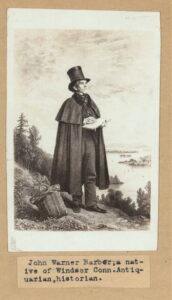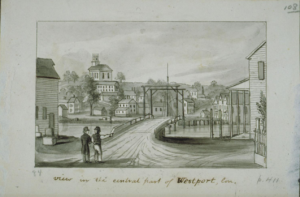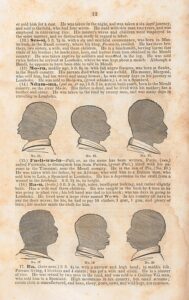By Emily Clark
Decades before photography became prevalent, a Connecticut artist captured the images and evidence of rural landscapes and small-town life in Connecticut. John Warner Barber chronicled 19th-century Connecticut history through his historical writing and hundreds of engravings—many of which still exist today.
Early Life in East Windsor

John Warner Barber – The New York Public Library. Used through Fair Use.
John Warner Barber was born in East Windsor in February 1798. His parents, Elijah and Mary, struggled to make a living on their northern Connecticut farm. After the death of his father, Barber went to work as a young teenager to support the family. Eventually, he took an apprenticeship with an East Windsor engraver named Abner Reed who taught him the art of printmaking—a skill that led him to become one of Connecticut’s most well-known illustrators and historians of the 19th century.
A Home and Business In New Haven
In 1823, at the age of 21, and after several years working beside Reed, Barber relocated to New Haven to open his own engraving shop. Barber quickly began to make a name for himself, producing religious books and historical texts with illustrations from his own engravings. Views in New Haven and Its Vicinity; With a Particular Description to Each View, which focused specifically on his adopted city, was one of Barber’s first publications. This 1825 text included drawings of the New Haven Green and the harbor.
Though his home and business were in New Haven, Barber traveled throughout Connecticut and the eastern seaboard making sketches of area landmarks such as churches, schools, inns, and town centers. While not a trained historian, he also collected bits of local history during his travels. Learning from other historians of the time, the young artist was able to capture the essence of city and small-town life in Connecticut and neighboring states.
Chronicling Connecticut and New England

John Warner Barber’s View in the central part of Westport, CT – John Warner Barber, Connecticut Museum of Culture and History. Used through Public Domain and Fair Use.
Among Barber’s most well-known books was Historical Collections of Connecticut, published in 1836. At 560 pages, this text—said to be one of the first popular local history books printed in the United States—sold thousands of copies during the first year in circulation. Its hundreds of images of Connecticut cities and towns began as rough pencil sketches and evolved into more detailed drawings. Engraved onto small blocks, those drawings became the foundation for Barber’s illustrations in the book.
The hundreds of illustrations of Connecticut secured Barber’s reputation as a celebrated engraver. A view of Colchester center, with residents strolling together, included the Congregational Church, Bacon Academy, and a small school for Black children. An image of seaweed-covered oyster huts on Milford harbor depicted Barber’s memories of the area from his visit in 1836. Though it was uncommon to see private homes among the drawings, he did include one of Samson Occom’s house in Montville, a simple dwelling belonging to a local Mohegan clergyman.
In addition to these sketches of idyllic scenes in Connecticut, Barber also captured the spirit of many Massachusetts towns, such as Hingham, Longmeadow, and Truro in his 1839 Historical Collections, Being a General Collection of Interesting Facts, Traditions, Biographical Sketches, Anecdotes &c., Relating to the History and Antiquities of Every Town in Massachusetts, with Geographical Descriptions. Throughout the early to mid-19th century, Barber had a significant role in the publication of dozens of historical chronicles of Connecticut, New England, and national history, though he never lived anywhere but his native state.
Collaboration with New Haven’s Black Community

A page from A History of the Amistad Captives – John Warner Barber, Wikimedia Commons, Public Domain CC0 1.0.
In addition to his illustrations, Barber played an active role in his community. A very devout Christian, Barber attended (often numerous) church services every Sunday—frequently worshipping with the African Ecclesiastical Society at the Temple Street Congregational Church. A fervent opponent of slavery, Barber supported and voted for the establishment of a Black college in New Haven in 1831. While the city voted against the college, Barber helped preserve the history of the incident in his own publications and personal records. Barber’s passion for history as well as equality also emerged in his publication, A History of the Amistad Captives, which detailed the Amistad trial and contained images of the enslaved Africans.
Attention to Historical Detail
Barber’s diaries—housed at the New Haven Museum—recorded his daily activities and interactions with local New Haveners, such as Simeon Smith Jocelyn and Amos Beman, and famous visitors, such as the Marquis de Lafayette. Preserved by such archives as Yale University’s Beinecke Rare Book and Manuscript Library, Barber’s publications, record books, and personal papers exemplify the everyday detail he brought to his historical record keeping.
John Warner Barber died in New Haven on June 22, 1885. Over the course of his life, he published dozens of books and contributed illustrations to countless more. Through his historical records and brilliant illustrations, Barber chronicled the culture and lifestyle of early Americans living in Connecticut and surrounding locales.
Emily Clark is a freelance writer and an English and Journalism teacher at Amity Regional High School in Woodbridge.









